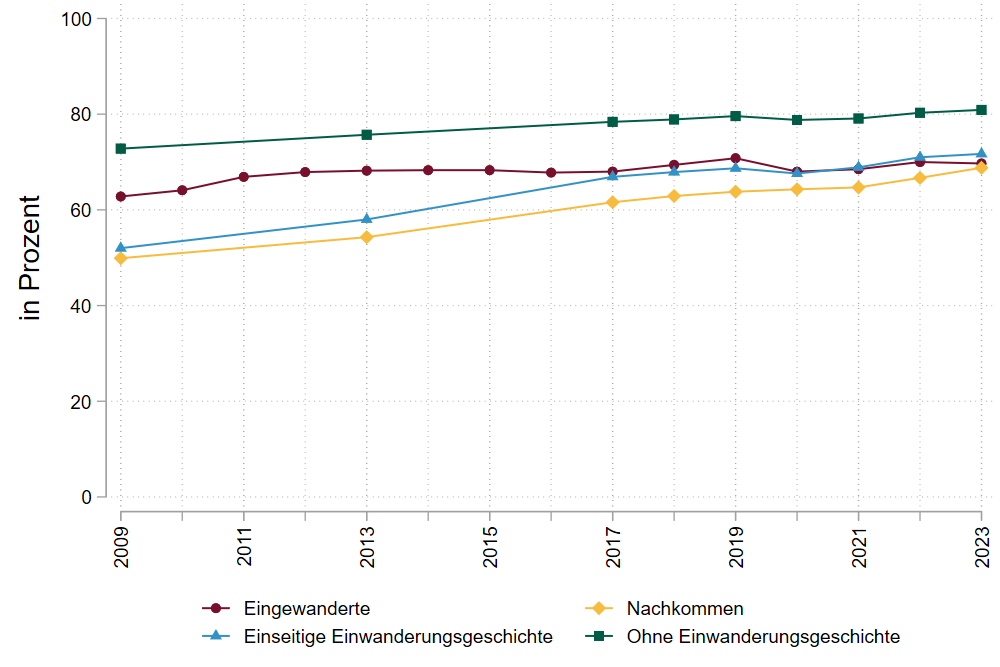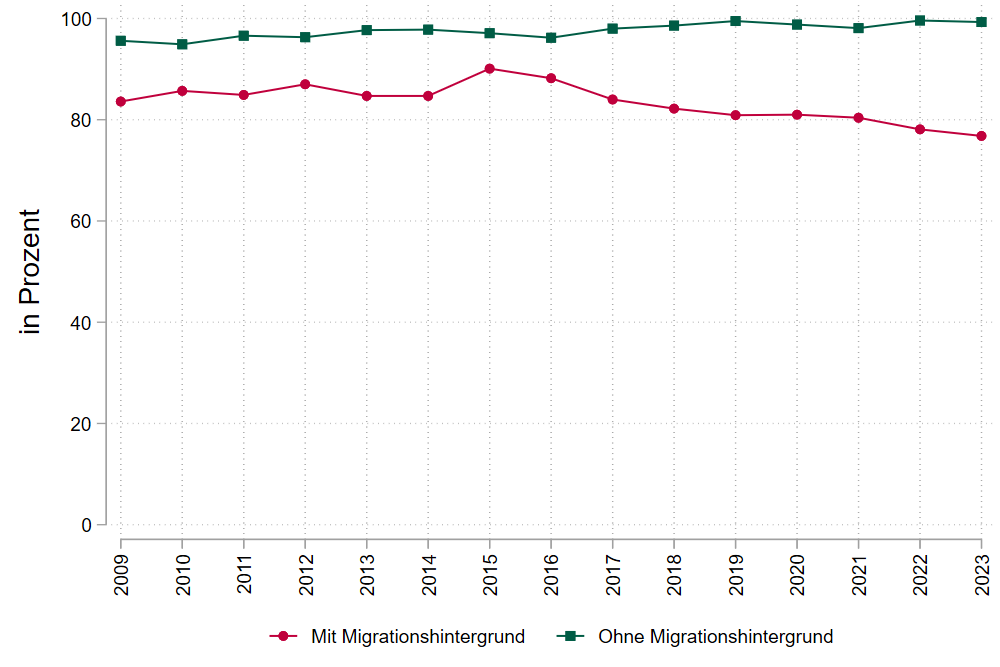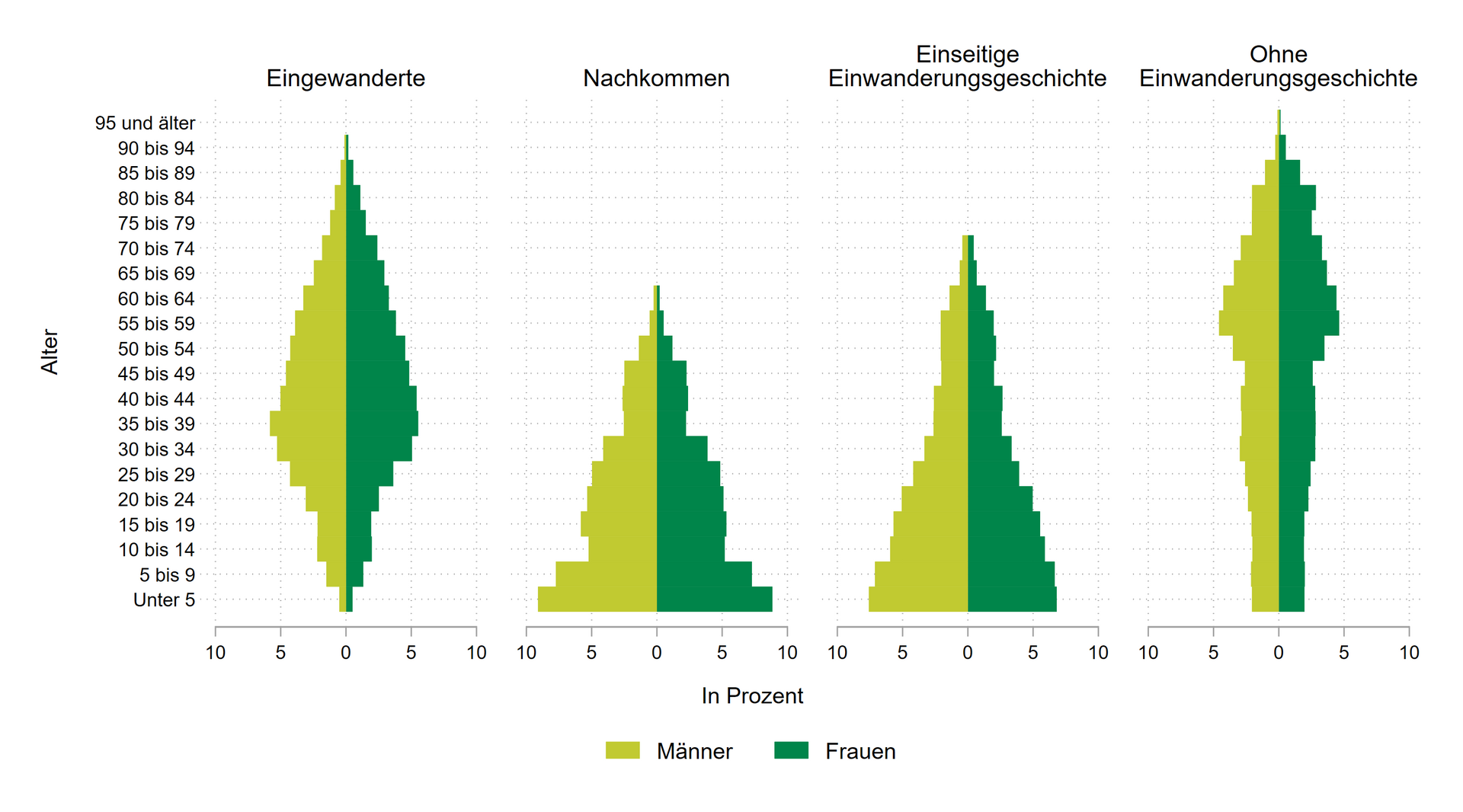- Home DeZIM Institut/
- News/
- Fact check on integration
Fact check on integration
Ten statements that are often heard in debates - and what the data really shows: Findings from DeZIM integration monitoring
The debate about migration and integration is often emotionalized in society. It is often characterized by missing or false information. This page provides scientifically sound facts and refutes recurring claims from public debates.
Wrong:
✔ Around 70% of working-age immigrants are employed and contribute to the financing of the welfare state. Employment rate 2023: 69.2 % of immigrants (15-64 years).
The vast majority of immigrants are employed and therefore have a regular income. In 2023, 69.2% of immigrants were1 of working age (15-64 years) were employed, compared to 77.5% of the working-age population as a whole.
Between 2005 and 2023, their employment rate increased by 11.9 %. This puts it above the level in most OECD EU member states. The labor market participation of immigrant men in particular is at a high level (77.6%), while that of immigrant women is slightly lower at just under 2/3 (60.6%) - there is still untapped potential here.
In addition, immigrants are more often precariously employed and perform jobs below their qualification level with less prestige and lower wages.2 Nevertheless, gainful employment enables them to lead a self-determined life, achieve greater life satisfaction, social prestige and participation and improve their German language skills.3 In addition, many immigrants work in occupations that are particularly affected by the shortage of skilled workers. More than 60% of employees without German citizenship work in skilled occupations (including specialists and experts) (see also point 4). They therefore make an active and important contribution to financing the welfare state and securing the labor force in Germany.4
Figure 1: Employment rate of 15 to 64-year-olds by immigration history (2005-2023)
Wrong:
✔ Over 80% of immigrants have social contacts with people without a history of immigration.
✔ The vast majority of immigrants and their descendants feel that they belong to Germany.
Immigrants and their descendants maintain social contacts with people without a history of immigration just as much as with people with a history of immigration. The vast majority (82% ) of immigrants and their descendants regularly receive people without a history of immigration in their homes or are received by them.
The social participation of people with a history of immigration requires the active involvement of immigrants, but also of the society already living here.5 The proportion of people without a migration background who maintain social contacts with people with a migration background rose by 12.9 percentage points between 2007 and 2019, indicating that the social networks of people without a migration background are also gradually becoming more diverse.
Most immigrants, descendants and people with a one-sided immigration history also have a strong sense of belonging to Germany (2022: 83.1%) - regardless of gender and age. Identification with the country of origin is usually not an obstacle to identifying with Germany. People who identify with their country of origin are no less likely to identify with Germany than people who do not identify with their country of origin.
Figure 2.1: Visits by/to people without and with a history of immigration (2007-2019)
Figure 2.2: Sense of belonging to Germany for all people and only for people who feel a sense of belonging to their country of origin, by immigration history (2016-2022)
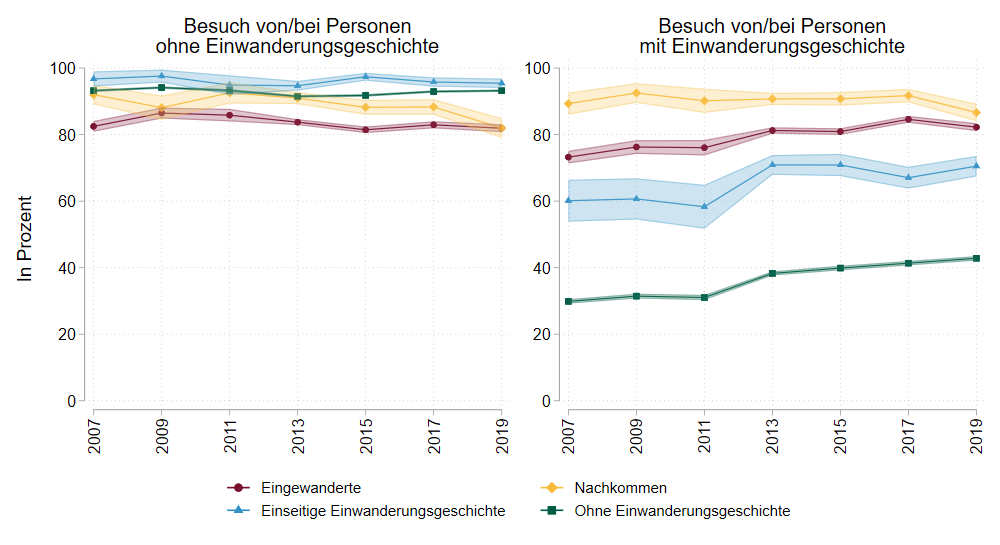
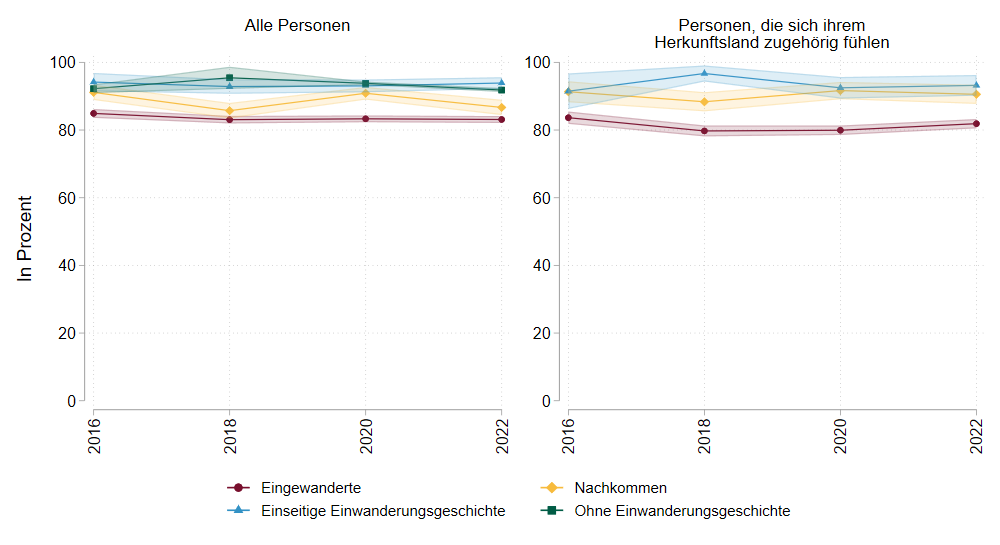
Wrong:
✔ Most hate crime violence in Germany comes from the right.
According to the BKA, there were 1,066 right-wing motivated acts of violence in 2023. This means that 67% of all violent hate crimes (1,591 offenses) were committed by right-wing extremists. 619 people were injured or killed as a result of these acts - this corresponds to almost two victims per day.6
In the same year, 128 acts of violence motivated by a foreign ideology and 53 acts of violence motivated by a religious ideology were registered. This corresponds to 8% and 3.3% of all hate crime violence.
It can be assumed that the dark field of right-wing motivated violence is higher than these BKA/BMI data suggest. Although the figures are not directly comparable, the Association of Counselling Centers for Victims of Right-Wing, Racist and Anti-Semitic Violence (VBRG) registered 2,589 right-wing, racist and anti-Semitic attacks in 11 federal states for the same year.7
Figure 3: Officially registered cases of hate crime violence by phenomenon 8 ( 2009-2023)
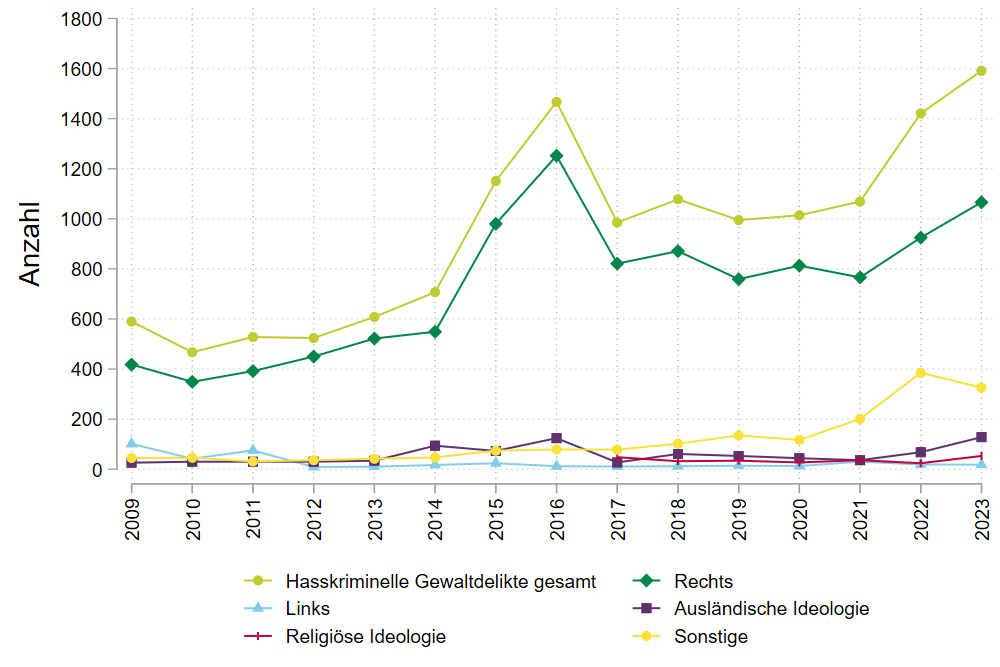
Wrong:
✔ People without German citizenship fill many urgently needed jobs in shortage occupations.
✔ The short-term unemployment rate for people with German citizenship has been falling continuously since 2009 (with the exception of the first coronavirus year 2020).
Demographic change and the shortage of skilled workers are already posing major challenges for the German economy.9
The number of people in employment will fall due to demographic change. Since 2012, the number of annual retirements has risen continuously from 1.2 million to a record high of 1.5 million in 2023.10 The labor market in Germany is therefore burdened by bottlenecks. Many people without German citizenship fill these urgently needed positions in bottleneck occupations and are indispensable in many professions. 1.3 million people without German citizenship work in occupations such as care, catering and transportation - in other words, where there is a shortage of skilled workers. Employees without German citizenship are particularly likely to work in the high-employment bottleneck occupations of catering service (2023: 35% of employees in catering service), as cooks (2023: 31.2% of employees) or as professional drivers (2023: 29.7% of employees).
The employment of people without German citizenship has not yet led to people with German citizenship losing their jobs and becoming unemployed more frequently. The short-term unemployment rate of German nationals shows a downward trend from 2009 to 2023 - with the exception of increases in the first year of the pandemic in 2020 (see: Dashboard integration). In addition, the long-term unemployment rate fell from 2009 to 2019 for people with (2009: 2.5 %, 2023: 1.6 %) and without German citizenship (2009: 6.3 %, 2023: 4.4 %) - despite high immigration since 2015.
Figure 4: Proportion of employees without German nationality in the ten occupations with the highest employment bottlenecks at skilled worker level (2023)
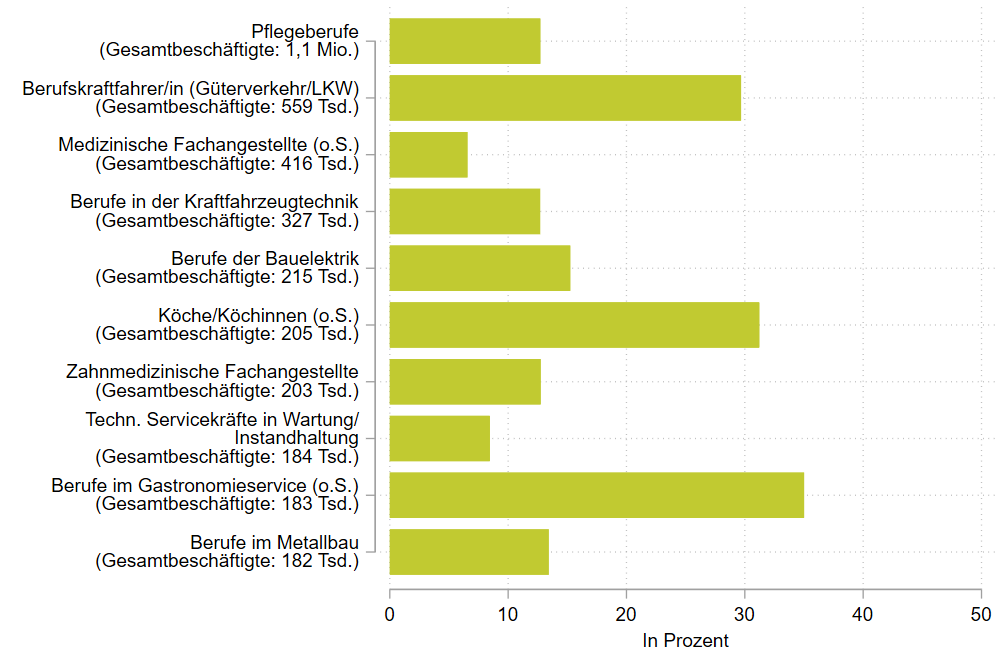
False:
✔ 76.8% of immigrants with more than 5 years of residence rate their German language skills as good or very good.
Many immigrants noticeably improve their German language skills the longer they stay. In 2021, 76.8% of those who have lived in Germany for five years or longer say they have good or very good oral German language skills. Of those who have lived in Germany for less than five years, the figure is 41.4%. This positive development is partly due to participation in integration courses and the opportunity to speak the language regularly in everyday life, at work and in social settings.
The success of German language support is also evident in a European comparison: the proportion of immigrants with advanced language skills - even though they only had low or intermediate skills when they arrived and have been living in Germany for at least five years - is the second highest in the European Union after Sweden.11
Figure 5: Proportion of immigrants with good to very good subjectively assessed oral German language skills by length of stay (2013-2021)
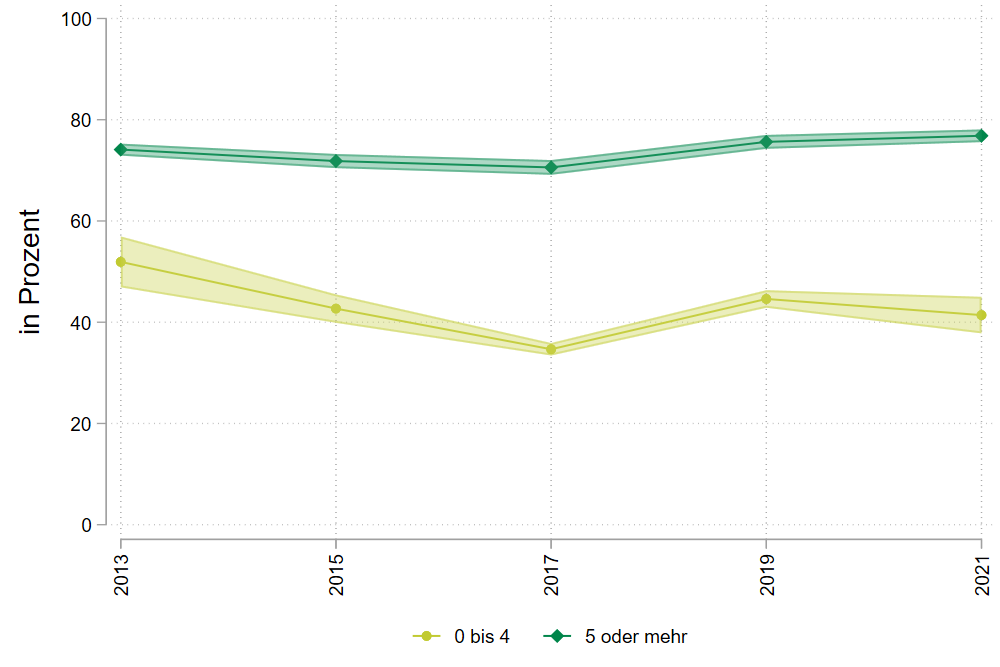
Wrong:
✔ Just under 80% of all children with a migrant background between the ages of 3 and under 6 will be in child daycare in 2023.
More than three quarters of all children with a migrant background between the ages of 3 and under 6 (76.8%) will be in child daycare in 2023.
The childcare rate has been declining since 2016 (2016: 83.6%). Since then, however, the number of children aged three to under six seeking protection has increased sixfold (2014: 24,360; 2023: 150,755).12 At the same time, the expansion of childcare places has stalled.13 In many cases, the need for childcare is greater than the supply,14 families with a migration background are particularly affected by this.15 If the families are also socio-economically disadvantaged, their needs are even less likely to be met.16 Furthermore, in some federal states, refugee children are not given access to daycare if they are still in initial reception facilities.17
Figure 6: Childcare rate for 3 to under-6-year-olds by migration background (2009-2023)
Wrong.
✔ Descendants and people with a one-sided immigration history are about as likely to be socially engaged as people without an immigration history.
✔ The vast majority of people with a history of immigration who are eligible to vote do so. The voter turnout of people with a history of immigration is only 6.8 percentage points lower than the voter turnout of people without a history of immigration.
Many people with a history of immigration contribute to solidarity in society. Of descendants and people with a one-sided immigration history, 36.7% and 40.7% respectively are socially engaged, compared to 43.9% of people without an immigration history. Slightly more than one in five immigrants are involved in voluntary work (20.3%).
In 2019, around half of all immigrants also provided informal support (49.4%). In contrast, the proportion of their descendants (60.5 %) and people with a one-sided immigration history (63.5 %) is on a par with people without an immigration history (61.5 %).
People with and without a history of immigration who are eligible to vote vote at roughly the same rate. In the 2021 federal elections, voter turnout among people with a history of immigration was 88.4%, only 6.8 percentage points below the turnout of people without a history of immigration. The high voter turnout indicates that people with a history of immigration are very interested in participating in political decisions and that they have confidence in democratic processes and institutions.
Note: These values are based on the post-election survey of the German Longitudinal Election Study. Unfortunately, survey data does not allow any direct conclusions to be drawn about actual voter turnout. Due to social desirability, more respondents often state in surveys that they have taken part in elections than is the case according to official election statistics. Assuming that the overestimation of voter turnout affects people with and without a history of immigration equally, the voter turnout rates of both groups can be compared with each other.
Figure 7.1: Voter turnout rate by immigration history (2009-2019)
Figure 7.2: Voter turnout in federal elections by immigration history (2009-2021)
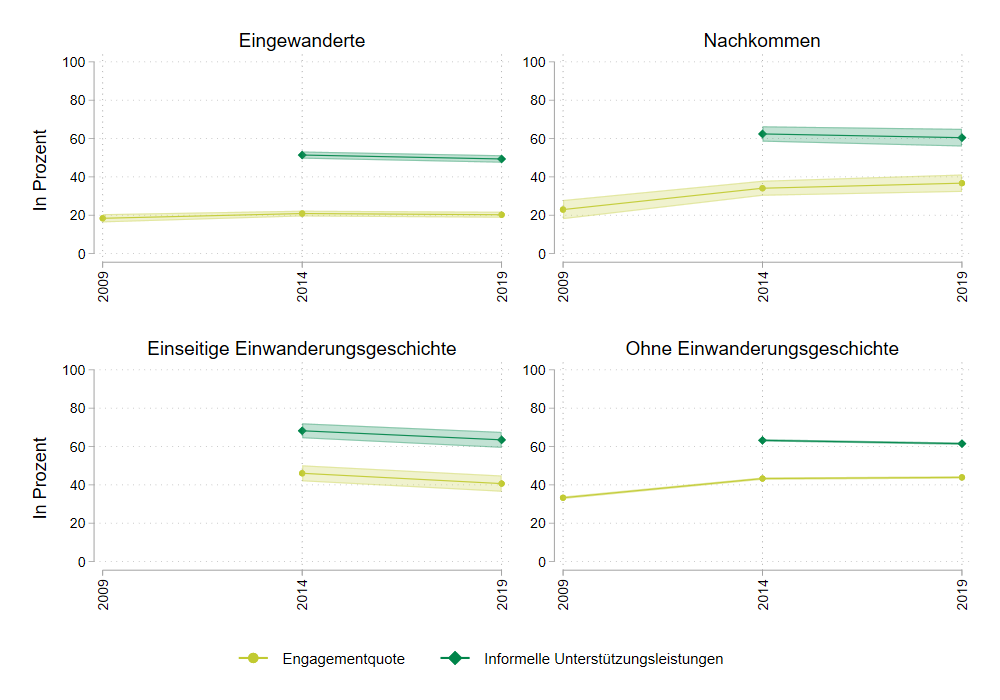
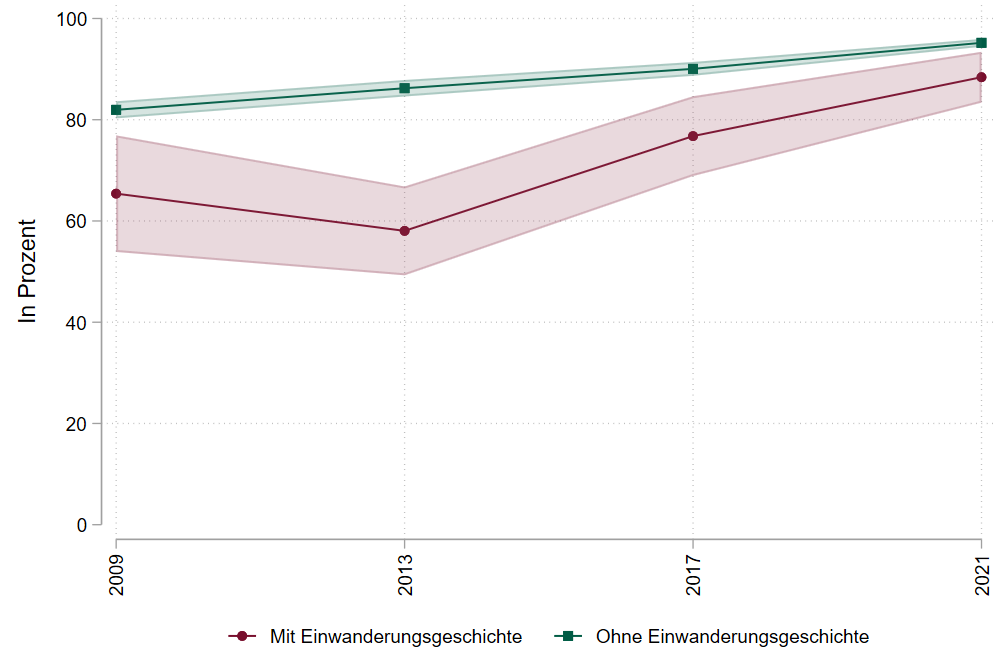
Wrong:
✔ Around 90% of the population recognizes that racism exists in Germany.
✔ Around 65% of the population recognizes that there is racial discrimination in German authorities.
Around 90 % of the population recognizes that racism exists in Germany.18 Although racism is usually more difficult to recognize at an institutional level than at an individual level,19 around 65 % of the population as a whole also state that there is racist discrimination in German authorities.20 This perception of racism is particularly pronounced among people with one or two immigrant parents, as well as among racialized people, i.e. people who are perceived by outsiders as belonging to a racialized group. However, 63.6% of people without a history of immigration and 62.6% of non-racialized people also agree that there is racial discrimination in public authorities. This suggests that many people do not need to have experienced racist discrimination themselves in order to become aware of the problem of racism.
Racism and discrimination continue to be a challenge to equal participation and equal opportunities in society. Rather than leading to advantages, racist discrimination can lead to material inequalities between people with and without a history of immigration by creating or reinforcing barriers to access to important goods and resources.
Figure 8: Perception of racial discrimination in German authorities by immigration history and by perceived attribution to a racialized group by outsiders (2021)
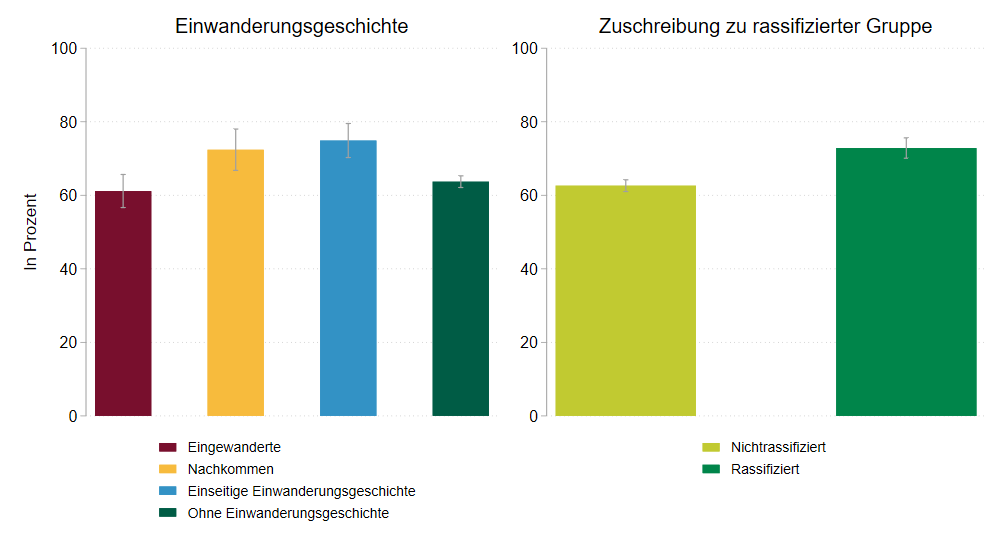
Wrong:
✔ Crime statistics reflect social risk situations - not origin.
According to the police crime statistics (PKS), 69.5% of all suspects reported to the police21 in Germany in 2023 were German nationals and 30.5% were not. The proportion of people without German citizenship therefore initially appears to be quite high. However, people without German citizenship are also more likely to be poor, young, male and live in cramped conditions - known risk factors for delinquent behavior, regardless of origin.
For example, 27.3% of people who have immigrated to Germany, around two thirds of whom do not have German citizenship, are at risk of poverty - compared to 11.8% of people without a history of immigration. People without German citizenship are on average 8.4 years younger than people with German citizenship (36.6 and 45 years). In addition, people with a history of immigration and without German citizenship increasingly live in cities - which are usually characterized by a higher crime density than rural areas.22
The fact that people without German citizenship are overrepresented in the crime statistics in proportion to their share of the population is not due to their immigration history or citizenship, but to location- and age-specific and socio-economic facts.23
Furthermore, people without German citizenship are more frequently checked and reported by the police.24 In addition, the data on suspects in the PKS is characterized by inadequacies. For example, the PKS only depicts the bright field, the cases known to the police, which in turn depends on the intensity of police checks and the reporting behavior of the population. In addition, the suspected cases registered in the PKS may turn out to be unfounded.25
Wrong:
✔ The proportion of women and men among immigrants, descendants and people with a one-sided immigration history is largely balanced.
On average, there are more men than women among those seeking protection from third countries (65.7% men). Among Ukrainian protection seekers, however, 63.9% are women.26
Overall, the proportion of women and men among immigrants, descendants and persons with a one-sided history of immigration hardly differs from that among persons without a history of immigration. It is largely balanced across all groups: 50.1 % of immigrants, 48.5 % of descendants, 49.1 % of persons with a one-sided immigration history and 51 % of persons without an immigration history are women.
Figure 9: Age and gender distribution by immigration history (2023)
- The evaluations and graphics are taken from the 14th Integration Report, which presents the status of integration of the population with a history of immigration (for an explanation of the term, see here) based on a broad data basis.
- The evaluations are based exclusively on representative data. This means that general conclusions can be drawn about the entire population group under consideration on the basis of the sample.
- Further data and facts on the topic of integration can be found in the 14th Integration Report and on the Integration dashboard
The concept 'Immigration history' was developed by the Federal Statistical Office following the report of the Federal Government's expert commission on the framework conditions for integration capability.
It divides the population into four groups:
Descendants (people where both parents have immigrated),
Persons with a one-sided immigration history (persons where one parent has immigrated)
Persons without a history of immigration.
Immigrants,
For immigrants and their descendants, 1950 is the relevant cut-off date. In contrast to the previously common concept of migration background, the concept of immigration history is based on the internationally accepted criterion of place of birth and does not take a person's nationality into account. Nationality can change in the course of a person's life, but can also persist over several generations. The place of birth, on the other hand, remains constant, which allows a more consistent analysis over time. In addition, the third and subsequent generations are no longer attributed an immigration history. Furthermore, within the second generation, the concept makes it possible to distinguish between descendants and persons with a one-sided immigration history. The new concept is therefore both more differentiated and more intuitively understandable than the concept of migration background.
Source: 14th Integration Report, p. 23
- 1Peoplewith an immigration history are immigrants and descendants where both parents immigrated. Descendants (one-sided immigration history) where only one parent has immigrated are not included in the population with an immigration history. A precise delimitation of these definitions is described in Chapter 5 Concepts and data.
- 2 Kogan, Irena: Arbeitsmarktintegration von Zuwanderern, in: Heinz Ulrich Brinkmann/Martina Sauer (eds.), Einwanderungsgesellschaft Deutschland. Entwicklung und Stand der Integration, Springer Fachmedien, Wiesbaden, 2016, pp. 177-199; Kogan, Irena: Last Hired, First Fired? The Unemployment Dynamics of Male Immigrants in Germany, European Sociological Review, Vol. 20, H. 5, 2004, pp. 445-461; Gatskova, Kseniia: Arbeitsmarktintegration der ukrainischen Geflüchteten in Deutschland, Ukraine-Analysen, H. 298, 2024, pp. 2-9.
- 3 Esser, Hartmut: Die Konstruktion der Gesellschaft, Campus, Frankfurt am Main, 2000; Diehl, Claudia/Schieckoff, Bentley: Integration durch Erwerbsarbeit: Voraussetzungen, Herausforderungen und die Rolle der Kommunen, Aus Politik und Zeitgeschichte, Vol. 71, H. 5/6, 2021; Kassenboehmer, Sonja/Haisken-DeNew, John: You're Fired! The Causal Negative Effect of Entry Unemployment on Life Satisfaction, The Economic Journal, vol. 120, p. 547, pp. 867-889; Schneickert, Christian et al.: Eine Krise der sozialen Anerkennung? Results of a population survey on everyday experiences of value and low esteem in Germany, Kölner Zeitschrift für Soziologie und Sozialpsychologie, Vol. 71, H. 4, 2019, pp. 593-622; Goßner, Laura/Kosyakova, Yuliya: Integrationshemmnisse geflüchteter Frauen und mögliche Handlungsansätze - eine Übersicht bisheriger Erkenntnisse, Institute for Employment Research, IAB-Forschungsbericht, H. 8, Nuremberg, 2021.
- 4 Fuchs, Johann et al.: Projection of the labor force potential until 2060: Demographic development causes the labor supply to shrink sharply, Institute for Employment Research, IAB-Kurzbericht, H. 25, Nuremberg, 2021.
- 5 Federal Ministry of the Interior and for Home Affairs: BMI - Lexikon. Important terms briefly explained, accessed on: 27.06.2024, online at: www.bmi.bund.de/DE/service/lexikon/functions/bmi-lexikon.html, 2024.
- 6 Special evaluation of the BMI.
- 7 https://verband-brg.de/wp-content/uploads/2024/05/VBRG-Jahresbilanz-rechte-Gewalt-2023-Alle-Grafiken-1.pdf
9 Burstedde, Alexander: The IW labor market forecast: Where will employees and the shortage of skilled workers in the 1,300 occupational categories be in five years? Methodological report, Institute of the German Economy, IW Report, H. 8, Cologne, 2023.
10 German Pension Insurance: Pension insurance in time series, 2023.
11 OECD: Status of integration of immigrants - Germany, OECD Publishing, Paris, 2024, Figure 7, p. 13.
12 Own calculation based on Federal Statistical Office: GENESIS-Online database. Table 12531-0001, status: 17.07.2024, Wiesbaden, 2024.
13 Expert Council for Integration and Migration: Annual Report 2024. Continuity or paradigm shift? The integration and migration policy of recent years, Berlin, 2024, p. 178.
14 Federal Ministry for Family Affairs, Senior Citizens, Women and Youth: Kindertagesbetreuung Kompakt. Ausbaustand und Bedarf 2023, Berlin, 2024, p. 15-19; Huebener, Mathias et al.: Frühe Ungleichheiten: Access to child daycare from an education and equality policy perspective, Friedrich-Ebert-Stiftung, Bonn, 2023.
15 Schmitz, Sophia et al: Continuing inequalities in daycare use, Bevölkerungsforschung Aktuell, vol. 44, no. 2, 2023, pp. 3-8; Lokhande, Mohini: Integrationsmotor Kita. How well is early childhood care prepared for the normal case of diversity? Sachverständigenrat für Integration und Migration, Berlin, 2023; Jessen, Jonas et al.: Understanding Day Care Enrolment Gaps, Journal of Public Economics, vol. 190, 2020, pp. 104252. The studies cited use the main language spoken at home, the migration background (also called immigration history by the SVR) and foreign-born parents to record the immigration history.
16 Huebener et al, 2023: Early inequalities: Access to child daycare from an education and gender equality policy perspective [as note 15].
17 Expert Council for Integration and Migration, 2024: Annual Report 2024 [see note 14], p. 178.
18 German Center for Integration and Migration Research: Racist Realities: How does Germany deal with racism? Initial study for the National Discrimination and Racism Monitor (NaDiRa), Berlin, 2022.
19 Federal Anti-Discrimination Agency: Discrimination in Germany - experiences, risks and case constellations. Fourth Joint Report of the Federal Anti-Discrimination Agency and the Federal Government Commissioner and the German Bundestag, Berlin, 2023.
21 It should be noted that people without German citizenship are on average more affected by demographic and social risk factors that increase the likelihood of delinquent behavior. They are also more likely to be checked and reported by the police.
23 See also: https://www.ifo.de/publikationen/2025/aufsatz-zeitschrift/steigert-migration-die-kriminalitaet-ein-datenbasierter-blick.
24 Müller, Maximilian/Wittlif, Alex: Racial profiling during police checks. Indizien aus dem SVR-Integrationsbarometer, Berlin, 2023; See also Aikins, Muna AnNisa et al.: Afrozensus 2020. Perspektiven, Anti-Schwarze Rassismuserfahrungen und Engagement Schwarzer, afrikanischer und afrodiasporischer Menschen in Deutschland, Berlin, 2021. sowieie: Dreißigacker, Leonie et al: Young people in Lower Saxony. Results of the Lower Saxony Survey 2022, Criminological Research Institute of Lower Saxony e.V., Hanover, 2023.
25 https://www.dezim-institut.de/aktuelles/polizeiliche-kriminalstatistik-2024/ .
8 These provide information about the recognizable ideological background of a crime and thus about the motivation of the perpetrators to commit the crime.

Dr. Svenja Kopyciok
Research Associate Department Consensus and Conflict
E-mail: kopyciok(at)dezim-institut.de

Dr. Maria Metzing
Head of Monitoring and Reporting
E-mail: metzing(at)dezim-institut.de
Phone: 030 / 200 754 207



Sandra Horvath
Research Associate Cluster Data - Methods - Monitoring
E-Mail: horvath(at)dezim-institut.de


